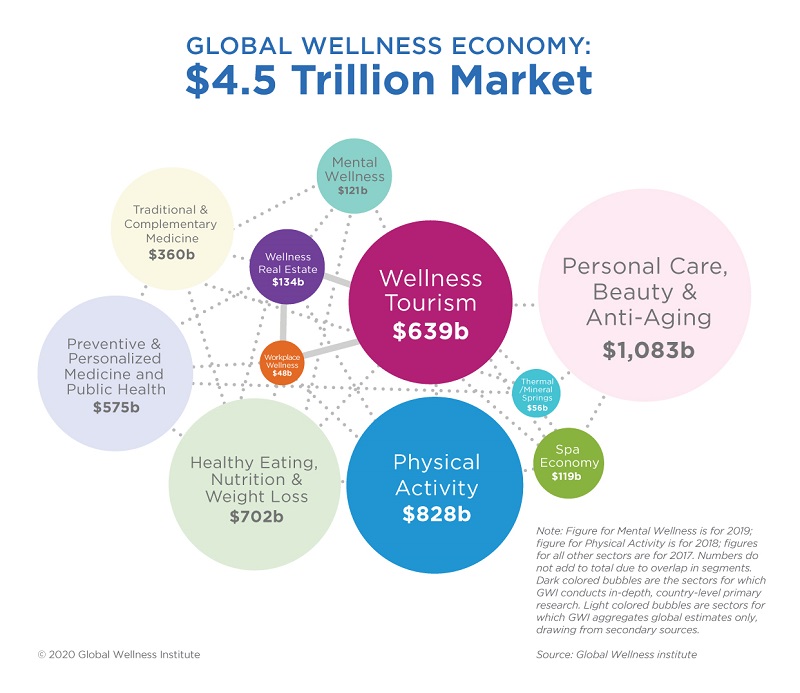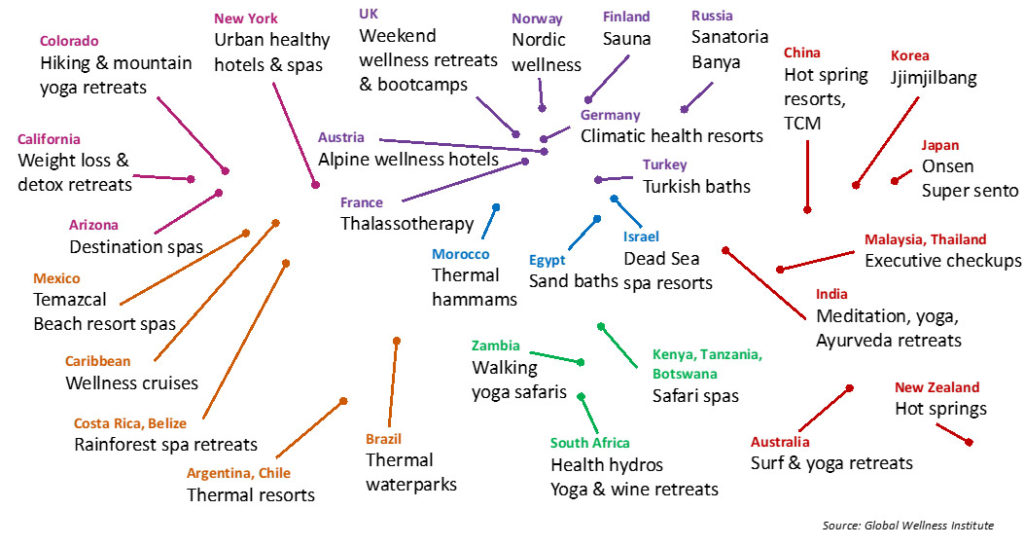Wellness Tourism

Wellness tourism is the powerful intersection of two large and growing industries: the $2.6 trillion tourism industry and the $4.2 trillion wellness industry. Holistic health and prevention are increasingly at the center of consumer decision-making, and people now expect to continue their healthy lifestyles and wellness routines when they are away from home.
In 2013, the Global Wellness Institute (GWI) unveiled the inaugural edition of the Global Wellness Tourism Economy report—a landmark study that defined the parameters and characteristics of the emerging wellness tourism sector, estimated its global size, and highlighted its far-reaching economic impacts. Since then, this tourism segment has accelerated around the world. GWI now estimates that wellness tourism is a $639 billion global market in 2017, growing more than twice as fast as general tourism.
Five Key Things to Know About Wellness Tourism
1. What is wellness tourism?
The Global Wellness Institute defines wellness tourism as travel associated with the pursuit of maintaining or enhancing one’s personal wellbeing. With so much unwellness embedded in today’s travel, wellness tourism brings the promise of combating those negative qualities and turning travel into an opportunity to maintain and improve our holistic health.
2. Wellness tourism is not medical tourism.
Wellness tourism is often conflated with medical tourism—not only by consumers but in destination marketing. This confusion is caused by an incomplete understanding of these markets and inconsistent usage of terminologies by destinations, government organizations, and promotion agencies. Sometimes the term “health tourism” is also used as a catch-all to describe many types of medical and wellness services and activities—from open heart surgery and dental care to destination spas and yoga retreats—causing further confusion. In fact, these two sectors operate largely in separate domains and meet different consumer needs.
There is some overlap between medical tourism and wellness tourism—for example, DNA testing or executive checkups. But in general, the types of visitors, activities, services, businesses and regulations involved are very different between medical tourism and wellness tourism, even though they may share a dependence on a region’s basic tourism and hospitality infrastructure and amenities.
3. Who are the wellness travelers?
There is a common misconception that wellness travelers are a small, elite and wealthy group of leisure tourists who visit destination spas, health resorts or yoga and meditation retreats. In fact, wellness travelers comprise a much broader and more diverse group of consumers with many motivations, interests and values.
GWI identifies two types of wellness travelers:
Primary wellness traveler: A traveler whose trip or destination choice is primarily motivated by wellness.
Secondary wellness traveler: A traveler who seeks to maintain wellness while traveling or who participates in wellness experiences while taking any type of trip for leisure or business.
Importantly, primary and secondary wellness travel can be done by the same person on different trips, and these two types of wellness travel reinforce one another. Over time, some secondary wellness travelers will decide to take a primary wellness trip, as their interest in and experience with wellness grows. For example, a person who visits a day-use hot spring during a family vacation (secondary wellness travel) may later be motivated to plan a weekend getaway staying at a hot spring resort (primary wellness travel).
4. Every destination has something unique to offer to wellness travelers.
Like other forms of specialty travel, wellness travel is not a cookie-cutter experience. Every destination has its own distinct flavors in relation to wellness, linked with its local culture, natural assets, foods, etc. Some travelers may be satisfied with a generic massage, exercise class or smoothie. The more discerning and sophisticated wellness travelers—especially those in the millennial generation—are interested in what the destination offers that is different from someplace else. These unique and authentic experiences can be built upon indigenous healing practices; ancient/spiritual traditions; native plants and forests; special muds, minerals, and waters; vernacular architecture; street vibes; local ingredients and culinary traditions; history and culture; etc. Because each destination is different, there is always something unique to offer wellness travelers.
Every destination has something unique to offer

5. Wellness tourism brings benefits to businesses and stakeholders beyond the wellness sectors.
The wellness tourism economy is much larger than a narrowly-defined set of typical wellness businesses, such as spas, wellness retreats, thermal/mineral springs and boot camps. Wellness travelers (especially secondary wellness travelers) are looking to continue their wellness lifestyle during travel, and this lifestyle may encompass healthy eating, exercise/fitness routines, mind-body practices, nature experiences, connections with local people and culture, etc., thereby creating opportunities for businesses such as yoga studios, gyms and fitness centers, healthy food stores/markets, events, arts and crafts, museums and many others.
In addition to wellness experiences, all wellness tourists need transportation, food and lodging, and they will likely seek out shopping or entertainment. All of these businesses—whether they are wellness-specific or not—benefit from wellness tourism and are part of the wellness tourism economy. There are numerous opportunities to infuse wellness into all kinds of amenities and services, which can help businesses differentiate, provide more value, and capture higher spending by wellness travelers. Examples include airport spas that target wellness travelers in transit; wellness-centered hotels for those who want better sleep and regular fitness routines; specialty restaurants serving healthy, organic or local cuisine; transportation companies that use clean fuels or low-/zero-emission vehicles; or gift shops that sell products that are connected to unique local wellness traditions.
Wellness tourism may help destinations mitigate the negative impacts of mass tourism or over-tourism. Because wellness travelers tend to be high-spenders and favor experiences that are authentic and unique, there is less pressure for destinations to engage in a “race to the bottom” strategy that competes on price and quantity.
Wellness tourism also provides destinations with an opportunity to reduce the seasonality of visitor flows. For example, ski destinations can attract wellness travelers interested in hiking and other outdoor activities in the summertime, while beach destinations can appeal to travelers who are looking for a more tranquil environment to de-stress or take a retreat in the wintertime. Source: Global Wellness Institute












